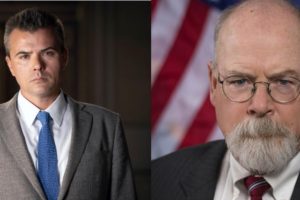On August 3, 1948, Time magazine’s associate editor Whittaker Chambers testified before the House Un-American Activities Committee that, in the 1930s, he had been “a member of the Communist Party and a paid functionary of that party.” He told the committee that he had worked with a network of federal employees to bring about “the Communist infiltration of the American government.” He identified former State Department official Alger Hiss as a member of his spy network.
Two days later, Hiss appeared before the committee and testified that he was not and never had been a member of the Communist Party, had never adhered to the tenets of the party, and denied knowing Chambers.
In a follow up private appearance before a HUAC subcommittee headed by Congressman Richard Nixon, Hiss challenged Chambers to repeat his accusations “outside the presence of the committee, without there being privileged (sic) for suit for libel. I challenge you to do it, and I hope you will do it damn quickly.”
On August 17, 1948, Chambers accepted Hiss’ challenge and, on NBC Radio’s Meet the Press, he stated that “Alger Hiss was a communist and may be now.” He added, “I do not think Mr. Hiss will sue me for libel or slander.”
One month later, Hiss sued Chambers for defamation. In the course of discovery, Chambers produced copies of stolen State Department cables that he claimed Hiss had provided to Chambers for use by Soviet intelligence. In addition to being a Communist, the civil discovery established that Hiss had been an active espionage agent for the Soviets.
This led to a criminal investigation. Before the grand jury Hiss denied under oath that he had passed copies of stolen government documents to Chambers. Consequently, he was indicted, convicted of perjury and sentenced to five years imprisonment.
The moral of this story is simple: never believe your own lies and, if you get caught in a lie, keep your mouth shut.
Which brings us to the recent lawsuit filed by the Democratic National Committee alleging an illegal conspiracy by President Trump, the 2016 Trump campaign, Republican strategist Roger Stone, Paul Manafort, Wikileaks and others with the Russian government to win the 2016 presidential election. Central to the conspiracy was the purported hacking by the Russian government of the DNC’s computers and the dissemination of the hacked emails to harm Hillary Clinton’s candidacy.
By its suit, the DNC is trying to break new legal ground. Apparently it believes that losing a political campaign is grounds for money damages…or something. The legal basis for recovery is murky at best.
But what is clear is that the DNC has pulled a colossal Alger Hiss. The hook upon which it has hung its case is the alleged hack by the Russians. Since this is central to its theory of liability, it is going to have to prove by a preponderance of the evidence (the level of proof in civil cases) that the Russians did the hacking and shared the results with the Trump campaign. On the other hand, the defendants are now able to legally test and challenge the truth of that claim.
Assuming the case survives a motion to dismiss for failure to state a valid legal claim, the DNC has just opened itself up to civil discovery by the defendants who can now compel the production of documents and other physical things as well as take the depositions of DNC officials, employees, associates, candidates and operatives. In short, the DNC has just invited the defendants to take a public romp through its most deeply held secret files.
One of the co-defendants, Republican strategist Roger Stone, has publicly stated that the lawsuit “is based on conjecture, supposition and projection with no evidence, facts or proof.” He also stated that he intends to examine the DNC’s servers for evidence of Russian hacking.
“The DNC lawsuit opens the door of discovery. My lawyers and I want to examine the DNC servers to settle this bogus claim of Russian hacking once and for all,” Stone declared.
A letter from Stone’s lawyers to the DNC said, “One purpose of this letter is to advise the DNC we intend to test the basic underlying claims that ‘Russians’ hacked, stole, and disseminated DNC data, rather than the various other plausible scenarios, including internal theft.”
Stone added that “The lawsuit is bogus, baseless, without merit- offering no hard proof to back up their fantasy that I conspired with a group of others to work with the Russians to hack the DNC and give the fruits of that hack to Wikileaks. It’s a fairy tale, a hoax and a canard.”
While such talk may be cheap, based on the available evidence, when it comes to challenging the Russian hacking story, Stone and his lawyers appear to be on solid ground. From the very beginning, that narrative has never passed the smell test.
On June 15, 2016, CrowdStrike, a private computer security company hired by the DNC, announced that it had detected Russian malware on the DNC’s computer server. The next day, a self-described Romanian hacker, Guccifer 2.0, claimed he was a WikiLeaks source and had hacked the DNC’s server. He then posted online DNC computer files that contained metadata that indicated Russian involvement in the hack.
On July 22, 2016, just days before the Democratic National Convention, WikiLeaks published approximately 20,000 DNC emails.
Much to the embarrassment of Hillary Clinton, the released files showed that the DNC had secretly collaborated with her campaign to promote her candidacy for the Democratic presidential nomination over that of Bernie Sanders. This caused the Clinton campaign serious political damage at the Democratic convention.
Well after the convention, Jennifer Palmieri, Clinton’s public relations chief, said in a March 2017 Washington Post essay that she worked assiduously during the nominating convention to “get the press to focus on… the prospect that Russia had not only hacked and stolen emails from the DNC, but that it had done so to help Donald Trump and hurt Hillary.”
But, when the Department of Homeland Security and the FBI learned of the hacking claim, they asked to examine the server.
And the DNC refused.
Why would the purported victim of a crime refuse to cooperate with law enforcement in solving that crime? Is it hiding something? Is it afraid the server’s contents will discredit the Russia-hacking story?
The answers to those questions began to emerge thanks to an article in the August 8, 2017 issue of the Nation. By no means a pro-Trump publication, the Nation published an exhaustive report about an exacting forensic investigation of the DNC hack by the Veteran Intelligence Professionals for Sanity (VIPS), an organization of former CIA, FBI, National Security Agency, and military intelligence officers, technical experts, and analysts.
As reported by the Nation, VIPS has a well-established record of debunking questionable intelligence assessments that have been slanted to serve political purposes. For example, in the run-up to the invasion of Iraq, VIPS courageously and correctly challenged the accuracy and veracity of the CIA’s intelligence estimates that Saddam Hussein possessed weapons of mass destruction and that he posed a threat to the United States. Similarly, VIPS has condemned the use of “enhanced interrogation techniques” on suspected terrorists. In short, VIPS can hardly be described as either a right-wing cabal or as carrying water for the Republican Party.
In its analysis of the purported DNC hack, VIPS brought to bear the impressive talents of more than a dozen experienced, well-credentialed experts, including William Binney, a former NSA technical director and cofounder of the NSA’s Signals Intelligence Automation Research Center; Edward Loomis, former NSA technical director for the Office of Signals Processing; and Skip Folden, a former IBM information technology manager. As the French would say, these are l’hommes serieux, as are the other computer-system designers, program architects, and analysts with whom they investigated the Clinton-DNC hack story.
As set forth in the article, VIPS’ investigative findings were nothing short of stunning.
First, VIPS concluded that the DNC data were not hacked by the Russians or anyone else accessing the server over the internet. Instead, the data were downloaded by means of a thumb drive or similar portable storage device physically attached to the DNC server.
How was this determined? The time stamps contained in the released computer files’ metadata establish that, at 6:45 p.m. July 5, 2016, 1,976 megabytes (not megabits) of data were downloaded from the DNC’s server. This took 87 seconds, which means the transfer rate was 22.7 megabytes per second, a speed, according to VIPS, that “is much faster than what is physically possible with a hack.” Such a speed could be accomplished only by direct connection of a portable storage device to the server. Accordingly, VIPS concluded that the DNC data theft was an inside job by someone with physical access to the server.
VIPS also found that, if there had been a hack, the NSA would have a record of it that could quickly be retrieved and produced. But no such evidence has been forthcoming. Can this be because no hack occurred?
Even more remarkable, the experts determined that the files released by Guccifer 2.0 have been “run, via ordinary cut and paste, through a template that effectively immersed them in what could plausibly be cast as Russian fingerprints.” In other words, the files were deliberately altered to give the false impression that they were hacked by Russian agents.
Thanks to the VIPS experts, the Russia-hacking claim — the lynchpin of the DNC’s lawsuit — appears to have been affirmatively and convincingly undercut.
Moreover, co-defendant Julian Assange has repeatedly denied that Russia “or any state actor” was the source of the stolen DNC data published by WikiLeaks. And his denials have just received confirmation in a recent issue of the New Yorker which features a lengthy and sympathetic portrayal of British spy Christopher Steele who gathered the dirt for the DNC funded anti-Trump dossier which forms the basis for the entire Trump-Russia collusion narrative.
Buried toward the end of the article comes the revelation that, on July 26, 2016 (four days after WikiLeaks published the DNC emails), “Steele filed yet another memo” in which “Steele’s sources claimed that the [DNC] digital attack involved agents ‘within the Democratic Party structure itself…’”
All of this raises many questions concerning the DNC’s Russia hacking claim as well as its involvement in spreading the rapidly disintegrating Trump-Russia collusion narrative.
After the DNC denied law enforcement access to its server, the FBI — under James Comey’s leadership — meekly agreed to accept the findings of CrowdStrike, the DNC’s private computer security firm, as to the server’s contents. This was in lieu of the FBI’s using legal process (such as a search warrant or forthwith grand jury subpoena) to seize and search the server for Russian malware and evidence of hacking.
Why did Comey and the FBI agree to such an impotent, absurd, and self-defeating arrangement? Did the DNC, Hillary Clinton or others collude with the Obama administration to prohibit such an examination? This would appear to be a fertile area for depositions of Attorney General Loretta Lynch, FBI Director Comey and others as to why the Obama Justice Department took no meaningful steps to properly investigate the Russia hacking narrative as alleged in the lawsuit. In addition to refusing an inspection of its server, did the DNC take affirmative steps to prevent such an examination? If so, why?
In the course of discovery, the defendants should have the DNC’s server and CrowdStrike’s work product analyzed to either confirm or disprove the presence of Russian malware. If none is found, they should investigate to determine who was responsible for that deception.
Similarly, they should have the DNC files released by Guccifer 2.0 analyzed to determine if they were, as VIPS has concluded, altered to give the false impression that the Russians had hacked the server. If so, who was responsible for the adulteration? If, as appears likely, the server was not hacked, why did Hillary Clinton and the DNC claim that it was?
Defense counsel should also investigate whether the DNC files were stolen by someone who had direct physical access to the DNC server. In that regard, who at the DNC had a motive to leak the files? Could it be someone who wanted to make public Clinton and the DNC’s underhanded treatment of Bernie Sanders?
Finally, since the DNC has alleged collusion by the defendants with Russia, then the eponymous Steele dossier, the very genesis of the Trump-Russia collusion story, should be open for investigation. Hillary Clinton, whose campaign funded the production of that dossier along with the DNC, would be a likely deponent along with Glenn Simpson of FusionGPS, Steele, Sidney Blumenthal and others who have reportedly been involved in composing the salacious and unverified contents of the dossier.
Plus, since the dossier was used by the FBI to illegally spy on the Trump campaign and administration, the role of the DNC, Clinton, Comey and others in that criminal undertaking would also be relevant to discrediting the collusion theory which underlies the DNC’s complaint as well as in support of a counterclaim for damages by those defendants who were spied upon.
These are but a few of the areas of inquiry that the DNC’s lawsuit has opened up to discovery. By filing its ill-conceived lawsuit, the DNC has laid itself bare to a painful, potentially embarrassing, and financially burdensome discovery process that stands a better than even chance of exposing the Russia-hacking and collusion stories as carefully orchestrated falsehoods by Clinton and the DNC
The great irony here is that the president and many of the other defendants have been calling for a special counsel investigation. Now, courtesy of the benighted DNC, they have been armed with subpoena power, the power to compel production of documents and other things, and the power to question witnesses under oath. And all of these powers will be used not by a remote and secretive independent special counsel, but by lawyers working directly for and solely for the benefit of the defendants.
Where will this process end? There’s a good chance it will come to rest at Lewisburg or its equivalent. That’s the Federal Correctional Institution where Alger Hiss served his time.




1 Comment
Leave your reply.